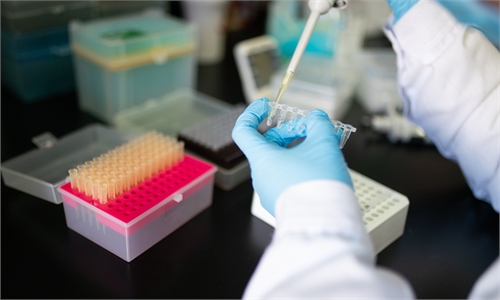
People shop at a shopping mall in Changchun, northeast China's Jilin Province, Jan 23, 2023. (Xinhua/Xu Chang)
The current round of the COVID-19 epidemic in Chinese mainland is nearing its end, the Chinese Center for Disease Control and Prevention (Chinese CDC) said in its latest issue of academic weekly journal.
The Chinese CDC published preliminary analysis of national data on the diagnosis, treatment and surveillance of COVID-19 infections in the China CDC Weekly on January 25, including monitoring data reported by provinces across the nation between December 9, 2022 and January 23, 2023. No new mutant strains have been identified so far, according to the analysis provided by the body.
According to official data, the recent wave of COVID-19 epidemic peaked in late December of 2022 and then maintained an almost uniform decline across all provinces, which was similar in both urban and rural areas. The number of outpatients, severe cases in hospital and deaths in hospital were all trending downwards. By late January of 2023, the overall nationwide spread of the virus had decreased to a lower level, relieving pressure on the country's medical system.
More specifically, the number of positive rate of nucleic acid tests reported from across the nation reached the highest at 29.2 percent on December 25, 2022 and the positive rate of antigen tests peaked at 21.3 percent on December 22, 2022. Both the positive rates of nucleic acid tests and antigen tests decreased to below 6 percent as of late January.
Meanwhile, the number of fever clinic visits in Chinese mainland peaked in late December of 2022 with Beijing, Tianjin and Hebei Province reaching their peaks earlier than other provinces.
As of late January of 2023, fever clinic visits at hospitals and health service centers in urban and rural areas both decreased by more than 90 percent from their recorded peak.
The peak of hospitalized COVID-19 patients nationwide came slightly later than that of infected patients, with the peak of 1.625 million reaching on January 5.
The number of severe cases in hospital peaked at 127,594 on January 5, and has since continued to fall, reaching 35,694 as of January 23.
The number of deaths with SARS-CoV-2 in hospital reached a daily peak of 4,273 on January 4 and continued to decline thereafter, falling back to 896 on January 23.
The Chinese CDC's analysis also shows that Omicron variants BF.7 and BA.5.2 were dominant during the recent wave with no new mutant strains being identified.
According to the Chinese CDC, China has continued to carry out virus mutation surveillance starting from early 2020. After December 12, 2022, three sentinel hospitals in three different regions will be selected in the provinces to monitor virus mutation. At the same time, surveillance of COVID-19 variants of inbound travelers will be carried out across land borders, seaports and airports.
From September 26, 2022 to January 23, 2023, 18,906 valid SARS-CoV-2 genome sequences from domestic cases were reported nationwide, with a total of 69 Omicron sub-lineages reported.
The predominant lineages are BA.5.2 (70.8 percent) and BF.7 (23.4 percent), followed by other 13 lineages, including BA.2.76, with the proportions ranging from 0.1 percent to 1.3 percent. The other 54 lineages were minority with their proportions below 0.1 percent, accounting for a total of 1.1 percent.
Global Times




